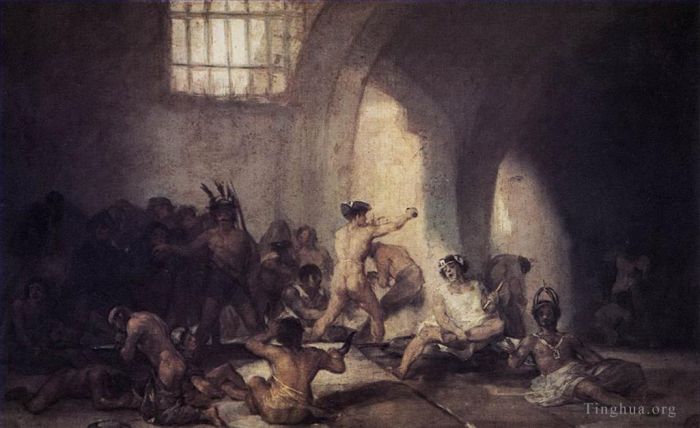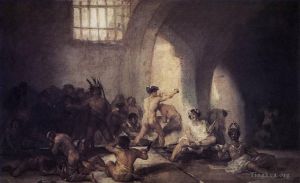The Madhouse
Francisco Goya
- Price: Price on Request
- Art Type: Oil Painting
- Size:
- English Comments: 0
- International Comments: 0
- Creating Date:
- Introduction and Works of Francisco Goya >>
Keywords:
Madhouse
Work Overview
- The Madhouse
Spanish: Casa de locos
Artist Francisco de Goya
Year 1812-1819
Medium Oil on panel
Dimensions 46 cm × 73 cm (18 in × 29 in)
Style Romanticism
Genre genre painting
Location Real Academia de Bellas Artes de San Fernando, Madrid
The Madhouse (Casa de locos) or Asylum (Manicomio) is an oil-on-panel painting by Francisco de Goya. He produced it between 1812 and 1819. It shows a mental asylum, with its inhabitants in many different poses.
Marked by Piranesian and claustrophobic architecture, the painting's only light source is a barred window high up on the wall, clearly meant to repress the figures below. These figures are distinct characters, all engaged in grotesque and pitiable behaviour - one wears what seems to be a wild-feathered headdress, another is fighting in a tricorne hat, another makes a gesture of blessing to the viewer, whilst many of the others are naked.
The subject of psychiatric institutions was a hot topic in the salons of the Spanish Enlightenment and so this painting could be meant as a denunciation of then-current practice in that area. Even if it is not, Goya was always attracted to representing madness, deformity or perversion. Some of the figures can also be interpreted allegorically, as a gallery of parodies of powerful figures in society, such as the clergy or the army (the man in the tricorne). It develops the topic of 'the world of dreams' ('mundo al revés') and is related to Goya's engravings series Los disparates.
Goya had already touched on the issue in his 1793 painting Yard with Lunatics, but The Madhouse shows greater variety, with less mad, less picturesque, more individualised and more characterised figures, shown more humanity and clearly marked as poor victims of marginalisation and rejection.
In many ways this version of a lunatic asylum is more conventional than Goya's earlier eye-witness account of The Yard of a Madhouse. It has been compared with Hogarth's scene in Bedlam in the Rake's Progress and some of Goya's deranged men, like Hogarth's, wear traditional attributes - a crown, a feathered headdress and tarot cards. But Goya's Bedlam is a much more horrifying sight, a place of darkness only partially lit, with the postures, gestures and expressions of the inmates indicating their pitiful condition. This is a dramatic and compassionate expression of the kind of scene he saw in Saragossa.
Goya's life-long concern for the plight of the insane as well as of prisoners and his continued interest in the physiognomy of madness is evident from the many drawings he made of various conditions of insanity.
- Copyright Statement:
All the reproduction of any forms about this work unauthorized by Singing Palette including images, texts and so on will be deemed to be violating the Copyright Laws.
To cite this webpage, please link back here.
- >> English Comments
- >> Chinese Comments
- >> French Comments
- >> German Comments
- >>Report
- Still life with fruit bottles breads
- The Meadow of San Isidro on his Feast Day
- The Swing
- Portrait of the Marchioness of Santa Cruz
- The Architect Don Tiburcio Perezy Cuervo
- The White Duchess
- The Duke of Wellington
- Knife Grinder
- Bullfight in a Divided Ring
- The Fair at Madrid
- Queen Maria Luisa Wearing a Mantilla
- King Carlos IV in Hunting Costume
- The Wedding
- The Maja and the Masked Men
- Don Ramon Satue
- The Fire
- The Countess of El Carpio
- The Parasol
- Don Manuel Osorio Manrique de Zuniga
- Fernando VII
- Fight With Cudgels
- The Marquesa de Pontejos
- Powder Factory in the Sierra
- The Straw Manikin
- The Black Duchess or Mourning Portrait of the Duchess of Alba
- Portrait of Mariano Goya
- Saturn Devouring His Son
- Juan Antonio Llorente
- Still life of Sheep Ribs and Head The Butcher conter
- Virgin Mary as Queen of Martyrs
- Mariana Waldstein
- Portrait of Maria Teresa de Vallabriga on horseback
- Majas on a Balcony
- Portrait of Victor Guye
- Portrait of the Countess of Chincon
- Bartholomew Suerda
- A Walk in Andalusia
- The military and senora
- Two Monks
- Winter The Snowstorm
- The Second of May 1808 (The Charge of the Mamelukes)
- Asensio Julia
- The Burial of the Sardine (Corpus Christi Festival on Ash Wednesday)
- Christ on the Mount of Olives
- Highwaymen Attacking a Coach (Robbery of the coach)
- Young Majas
- The picnic
- Charles III
- Sebastian Martinez
- Maja and Celestina on a Balcony
- The school scene
- The Pilgrimage of San Isidro
- Procession of Flagellants
- The Burial of Christ
- Portrait of the Countess of Carpio
- Marquesa de Pontejos
- The Family of the Infante Don Luis
- The Blind Guitar Player
- Don Juan Antonio Cuervo
- The Great He-Goat Or Witches Sabbath
- Portrait of Francisco Bayeu
- Time of the Old Women
- Nude Maja
- Bullfight
- The Repentant Saint Peter
- Truth Rescued by Time
- The Marquesa de la Solana
- Charles IV of Spain and His Family
- Infante Don Sebastian Gabriel de Borbon y Braganza
- Village Procession
- The Arrest of Christ
- Dona Tadea Arias de Enriquez
- Robbery
- Self portrait 2
- Still life plucked turkey and pan with fish
- Clothed Maja
- The Sacrifice to Vesta
- Blind Man Playing the Guitar
- The Quail Shoot
- Summer or The Harvest
- Self Portrait2
- Ferdinand Guillemardet
- The Duke of Osuna and his Family
- The Strolling Players
- Portrait of Senora Berm sezne Kepmesa
- El Lazarillo de Tormes
- St Francis Borgia Helping a Dying Impenitent
- Sketch for The Death of Saint Joseph
- Duchess Countess of Benavente
- Duke of Alba
- The Crockery Vendor
- Village Bullfight
- Portrait thought to be Josepha Bayeu
- Portrait of Jose Antonio
- The Third of May 1808 (The Executions)
- Still Life with Sheeps Head
- The Second of May 1808
- Self portrait 1
- Pedro Romero
- Count Fernand Nunez VII
- The Colossus
- Duke of Alba 2
- Dona Isabel Cobos de Porcel
- Self portrait in the Studio
- Dismemberment of the corpse of Jesuit Brefeb
- Plague Hospital
- The Holy Family
- The Last Communion of St Joseph Calasanz
- Portrait of charle iv of spain
- Boys playing soldiers
- The Snowstorm
- Self Portrait
- Water Carrier
- Vagabonds Resting in a Cave
- The Bookseller Wife
- Dona Narcisa Baranana de Goicoechea
- Dead Birds
- Cardinal Luis Maria de Borbon y Vallabriga
- Autumn or The Grape Harvest
- The Fall or The Accident
- The ill matched Couple
- Ferdinand 7in his Robes of State
- Old eating soup
- Don Pedro
- Triple generation
- The Shipwreck
- Allegory of the City of Madrid
- Portrait of Ferdinand VII
- The Annunciation 1785
- Picador Caught by the Bull
- Brigand Stripping a Woman
- Manuel Godoy
- St Bernardino of Siena preaching to Alfonso V of Aragon
- The Adoration of the Name of The Lord
- Maria Luisa of Parma wearing panniers
- Dead turkey
- Crucified Christ
- Attack on a Coach
- The Madhouse
- Ferdinand VII
- Young Woman with a Letter
- Playing at Giants
- The Duke and Duchess of Osuna and their Children
- The Third of May 1808
- Actress Antonia Zarate
- The Clothed Maja
- Scene of Rape and Murder
- The Sacrifice to Priapus
- Promenade of the Holy Office
- Self portrait with spectacles
- Portrait of Maria Teresa of Ballabriga
- Portrait of Don Jose Queralto
- Blind Man s Buff
- Atropos The Fates
- General Jose de Palafox
- The Pottery Vendor
- Hanibal vencedor contempla Italia desde los Alpes
- Portrait of the Wife of Juan Agustin Cean Bermudez
- Gaspar Melchor de Jovellanos
- Scene of a bullfight
- Self portrait_2
- Portrait of Andres del Peral
- Don Andres del Peral
- Witches in the Air
- The Countess of Chinchon
- The Woman with a Fan
- Procession of Flagellants on Good Friday
- La Tirana
- Senora Sabasa Garcia
- Fight with a young bull
- Saint Ambrose
- Francisco de Cabarrus
- Young People Laughing
- Sharing the Old Woman
- Birth of the Virgin
- Josefa Bayeu or Leocadia Weiss
- Sketch for Truth Rescued by Time
- The Duchess of Alba and Her Duenna
- Dona Maria Tomasa Palafox
- Juan Martin Diaz
- Boys With Mastiff
- Maunel Silvela
- Picnic
- The Marquesa de Pontejos
- Queen Maria Luisa
- Fight_with_a_Young_Bull
- Duke of San Carlos
- St Gregory the Great
- Juan Antonio Melendez Valdes
- Pilgrimage to the Church of San Isidro
- Portrait of Ferdinand Guillemardet
- Self Portrait in the Workshop
- Portrait of Mariana Waldstein
- Dona Teresa Sureda
- Inquisition Scene
- The Family of the Duke of Osuna
- Portrait of Maria Teresa de Vallabriga on horseback
- The Kite
- Incantation
- Picnic on the Banks of the Manzanares
- Dona Isabel de Porcel
- The Milkmaid of Bordeaux
- Still Life Three Salmon Steaks
- A Prison Scene
- Self-portrait with Dr Arrieta
- The Injured Mason
- Festival at the Meadow of San Isadore
- The Greasy Pole
- The Annunciation
- The sleep of reason brings forth monsters
- The Yard of a Madhouse (Yard with Lunatics)
- Francisco Bayeu
- Pepito Costa and Bonells
- Francisca Sabasa y Garcia
- The Bewitched Man
- The Miracle of St Anthony
- Dr Pearl
- Quejate al tiempo Accuse the Time
- Dance of the Majos at the Banks of Manzanares
- The Count of Floridablanca
- Portait of Maria Teresa de Borbon y Vallabriga
- Prison Scene
- Antonia Zarate
- Equestrian portrait of Maria Luisa of Parma
- A woman and two children by a fountain
- Self Portrait 1815
- Y Lucientes Francisco De Self Portrait
- Fire at Night
- Witches Sabbath









 Singing Palette
Singing Palette